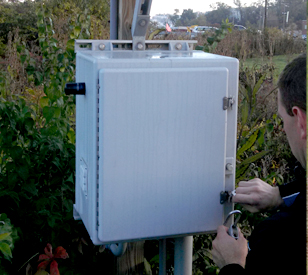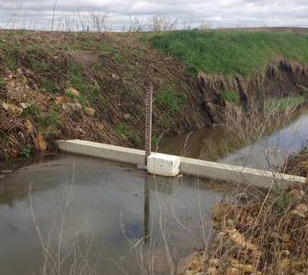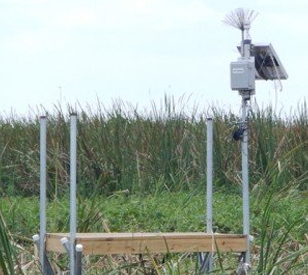Nutrient Monitoring System

Excess nutrients, also known as eutrophication, can appear seasonally, after an upwelling of nutrient-rich water, or from human-introduced sources such as fertilizer runoff, feedlot waste, urban stormwater runoff and wastewater treatment plant discharge. Watersheds increasingly struggle to handle resulting nutrient loads and suffer adverse effects such as harmful algal blooms (HABs), red tides, fish kills, and decreased productivity. Better understanding of nutrient loads and mitigation can be achieved in part through automated, real-time monitoring systems.
Nutrient Monitoring

Typical Nutrient Monitoring System
An effective nutrient monitoring system should provide real-time measurement data not only at the body of water subject to harmful algal blooms, but also along tributaries that transport nutrients through the watershed when possible. By measuring at multiple locations, point sources can be located and predictive modeling can be developed to provide advanced warning when the conditions are right for HABs to propagate.
Nutrient monitoring networks may include both buoy-based and structure-mounted sensors. A typical system may consist of several mast-mounted NexSens X3 environmental data loggers dispersed throughout a watershed or concentrated closer to one location known to be susceptible to excess nutrient loads. The X3 transmits data wirelessly in real-time via 4G LTE cellular or Iridium satellite communications to the WQData LIVE web datacenter, where data can be viewed and exported and alarms configured.
The most common sensor types deployed in nutrient monitoring networks are nitrate sensors such as the TriOS NICO UV nitrate sensor and blue-green algae sensors like those from YSI, Turner Designs, Eureka and In-Situ. Various other sensor types including weather stations, temperature profiling strings, underwater PAR sensors, dissolved oxygen (DO) and carbon dioxide sensors may be used in a nutrient monitoring network. All of these sensor types are compatible with the X3 data logger, which automatically detects sensors and facilitates data transfer to WQData LIVE.
Contact a NexSens Applications Engineer today to discuss your nutrient monitoring application.

Case Studies
Lake Erie Tributary Monitoring
The western basin of Lake Erie gets a lot of attention thanks to its role in large algal blooms, but it is not the only part of the lake affected by nutrient runoff. There are organizations all around Lake Erie that work to manage runoff going into different basins of the lake. One of those is the Northeast Ohio Regional Sewer District, which maintains multiple water quality monitoring stations along creeks and rivers that flow into Lake Erie’s waters near Cleveland.
Read MoreWeir Installation Water Quality Effects
Because of its location in an agricultural watershed, a ditch in Minnesota’s Blue Earth County was retrofitted with a weir to help control discharges of excess nutrient and sediment loads. Curious to see what effects the new construction had on conditions downstream, researchers at Minnesota State University set out to investigate. They began with a set of baseline data gathered between the months of April and November in 2013. These touched on the stream’s temperature, pH and dissolved oxygen levels, which they found to be increasing in a correlated way significantly throughout the day.
Read MoreFlorida Wetland Nutrient Transport
Officials at the South Florida Water Management District oversee many stormwater treatment areas as part of their mission to manage and protect water resources in southern Florida. Those include many constructed wetlands, some with aquatic vegetation and some without. Because the effects of aquatic vegetation on nutrient transport in wetlands are relatively unknown, scientists with the Management District set up monitoring equipment to learn more. Their investigation looks specifically at the role that wind plays in wetland nutrient transport, given the presence or absence of vegetation.
Read More






